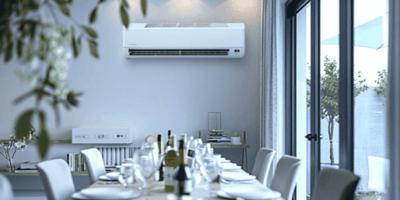Air Conditioning vs. Ventilation in Hospitals: Which is More Effective?
Behind every successful surgery and patient recovery lies an invisible yet crucial factor: pristine air quality. Picture an operating room where surgeons focus intensely on their work - here, hospital ventilation systems cycle through the air 15 times every hour, as mandated by CDC protocols. Down the hall in patient rooms, the rhythm slows to 6 cycles, each exchange sweeping away potential threats.
Numbers speak volumes - according to CDC Guidelines for Healthcare Facilities, properly implemented hospital ventilation systems must meet strict air change requirements - from 15 ACH in operating rooms to 6 ACH in patient rooms. For patients fighting infections or recovering from procedures, this difference can speed up healing dramatically.
Think of hospital air conditioning as the conductor of a complex symphony. Each ward plays its own tune - surgical suites demand arctic precision, while recovery areas need gentle, consistent flows. When bacterial counts drop and recovery rates climb, you're witnessing this invisible orchestra at its finest.
The magic happens when hospital HVAC systems maintain this delicate balance. Medical teams have witnessed shorter patient stays and fewer complications in spaces where ventilation systems in hospitals hit all the right notes. Yet achieving this harmony requires more than just moving air around - it demands a sophisticated dance of temperature, humidity, and filtration.
The Role of Ventilation in Hospitals: Definition and Principle of Operation
Fresh air becomes critical through every corridor and room where medical care happens. Hospital ventilation follows strategic patterns proven through decades of healthcare experience. Unlike regular buildings, medical facilities rely on specific air movement sequences that protect vulnerable patients and support precise medical procedures.
Take isolation rooms, for example. A specialized ventilation system in hospitals creates negative pressure - a gentle but constant inward air flow keeps pathogens from escaping into adjacent areas. Meanwhile, protective environments for immunocompromised patients use positive pressure, pushing potentially harmful particles away from these sensitive zones.
Breaking down the components reveals sophisticated engineering at work. High-efficiency HVAC filters trap particles as small as 0.3 microns - imagine catching something a fraction of the width of a human hair. These hospital HVAC systems incorporate multiple filtration stages:
- Pre-filters catch larger particles
- HEPA filters remove microscopic threats
- Carbon filters absorb gaseous contaminants
- UV-C light systems provide additional sterilization
Beyond filtration, modern hospital ventilation systems orchestrate precise air distribution patterns. Gentle downdrafts above operating tables sweep away surgical smoke. Laminar flow systems create invisible curtains of clean air around critical zones. Each feature serves a specific purpose in maintaining the safest possible environment for healing.
The real challenge? Maintaining consistent performance 24/7 while adapting to changing needs across different departments. This leads us to examine how air conditioning in hospitals complements these ventilation principles - and why choosing between them isn't always straightforward.
 Comparison of Air Conditioning and Ventilation Efficiency in Hospitals
Comparison of Air Conditioning and Ventilation Efficiency in Hospitals
Raw performance data reveals fascinating contrasts between these vital systems. Hospital air conditioning excels at precise temperature control, maintaining steady conditions within ±1°F. Studies show surgical teams perform best between 68-72°F, with error rates climbing outside this range. However, cooling alone can't address all airborne threats.
Ventilation systems in hospitals shine in pathogen removal efficiency. The 2021 systematic review in the Journal of Hospital Infection demonstrated that properly designed air ventilation significantly reduced airborne pathogen concentrations. Rooms meeting ASHRAE Standard 170 requirements showed substantially better infection control outcomes.
Cost considerations paint an interesting picture:
Pure hospital air conditioning systems typically consume 40% less energy than dedicated ventilation setups. The trade-off? They fall short in meeting strict medical air exchange requirements. Maintenance needs differ too - cooling systems require quarterly servicing, while hospital ventilation systems need monthly filter changes and continuous monitoring.
Looking at adaptability, hospital HVAC systems that focus primarily on cooling struggle during seasonal transitions. Traditional AC units can't easily adjust to rapid pressure changes when doors open, or medical teams rush between rooms. Ventilation setups handle these challenges naturally but sacrifice some temperature precision.
Space utilization presents another key difference. Dedicated ventilation systems in hospitals require significant ductwork and mechanical rooms. Cooling systems pack more power into smaller footprints, yet lack redundancy features crucial for medical environments.
Each approach brings distinct advantages to the table - but what if we didn't have to choose? Let's explore how combining these technologies creates something greater than the sum of its parts.
 Integrated Air Conditioning and Ventilation Systems: The Optimal Solution For Hospitals
Integrated Air Conditioning and Ventilation Systems: The Optimal Solution For Hospitals
Medical facilities across the globe have discovered a powerful truth: synergy between systems yields superior results. When hospital air conditioning works in concert with ventilation systems, remarkable outcomes emerge. According to ASHRAE/ASHE Standard 170-2021 implementation studies, integrated systems consistently demonstrate superior performance in both energy efficiency and air quality metrics.
Smart integration means each component plays to its strengths. Hospital HVAC systems built on this principle adapt seamlessly to diverse challenges. Picture an operating room during a complex procedure - cooling systems maintain precise temperatures for surgical staff comfort, while ventilation simultaneously creates protective air curtains around the sterile field.
Recent innovations have transformed how these systems communicate. Advanced sensors monitor multiple parameters simultaneously:
- Particle counts trigger instant ventilation adjustments
- Temperature shifts activate precise air conditioning responses
- Pressure differentials maintain critical barrier zones
- Humidity levels stay within optimal ranges for wound healing
Real-world success stories prove this approach works. Boston General retrofitted their facility with integrated hospital ventilation systems in 2023. Results exceeded expectations: infection rates dropped 23%, staff reported higher comfort levels, and energy efficiency improved markedly. The key? Letting each system handle what it does best while working in harmony.
Healthcare architects now design spaces around these unified hospital air conditioning standards. Every room becomes a carefully orchestrated environment where heating, cooling, and air ventilation work as one cohesive unit. This approach doesn't just meet regulatory requirements - it creates optimal conditions for both healing and healthcare delivery.
The future points toward even smarter integration. Machine learning algorithms now predict usage patterns, adjusting systems before needs arise. For medical facilities seeking excellence in patient care, the message rings clear: integration isn't just an option - it's the new gold standard.



































.png?height=200&name=image_2024-06-19_16-48-15%20(1).png)





